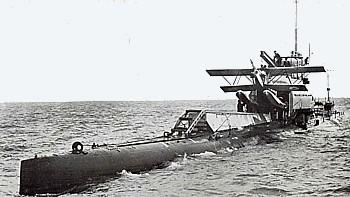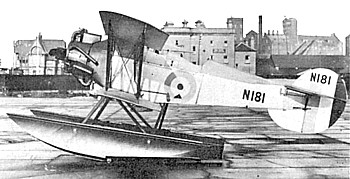Library Reference Number: 215
Submarine Launched Aircraft - M2
On reading a recent addition to the SSAA library about the Japanese 'Iwo Jima' class submarines carrying aircraft, I was reminded of an article I had written for a book some years before and where this aspect of naval aviation had been covered in some detail. In recent years, there have even been submarine launches of F16 fighter and stealth aircraft by the US Navy in a manner akin to a missile but the idea of transporting and launching aircraft from a submarine goes back to the years following World War One. The following article describes the British response to French plans concerning the construction and deployment of the Surcouf (see library index 214) and based upon the former 'K' class 'steam powered' submarines.
 In modern times, it might seem ridiculous that anyone would design and build such a craft until it is realised that even the best modern submarine is essentially steam powered and using nuclear energy to generate super-heated steam to drive the propeller. During World War One, more conventional technology was applied with coal burning boilers and meaning that the 'K' class submarine was large and clumsy at 320 feet long and with considerable space allocated to coal bunkers. Diving meant dowsing the fires of the boilers and closing off the funnels before the electric motors took on the duty of submersed propulsion. Even before they were built, some senior Admirals questioned their ability and use in wartime. Technically, they were too slow to sail with the fleet and suffered from major design defects. In January, 1918, 'K' became known as 'Kalamity' during an incident close to the May Isle in Scotland and forever remembered as the 'The Battle of the May Island' and where two hundred and seventy British sailors were killed without the enemy being present or even aware of the incident; the event being quickly classified and rated as 'top secret' within days following the dreadful accident. As a result, most K class vessels were quickly decommissioned and consigned to scrap yards upon conclusion of the war. K18, K19, K20 and K21 were withdrawn to Portsmouth where they received extensive modifications and were re-designated as 'M' class submarines. They found little favour with their crews who dubbed them as 'Mutton Boats'.
In modern times, it might seem ridiculous that anyone would design and build such a craft until it is realised that even the best modern submarine is essentially steam powered and using nuclear energy to generate super-heated steam to drive the propeller. During World War One, more conventional technology was applied with coal burning boilers and meaning that the 'K' class submarine was large and clumsy at 320 feet long and with considerable space allocated to coal bunkers. Diving meant dowsing the fires of the boilers and closing off the funnels before the electric motors took on the duty of submersed propulsion. Even before they were built, some senior Admirals questioned their ability and use in wartime. Technically, they were too slow to sail with the fleet and suffered from major design defects. In January, 1918, 'K' became known as 'Kalamity' during an incident close to the May Isle in Scotland and forever remembered as the 'The Battle of the May Island' and where two hundred and seventy British sailors were killed without the enemy being present or even aware of the incident; the event being quickly classified and rated as 'top secret' within days following the dreadful accident. As a result, most K class vessels were quickly decommissioned and consigned to scrap yards upon conclusion of the war. K18, K19, K20 and K21 were withdrawn to Portsmouth where they received extensive modifications and were re-designated as 'M' class submarines. They found little favour with their crews who dubbed them as 'Mutton Boats'.
Despite this, the Navy ordered a further six K-Boats in June 1918, but upon conclusion of the war, most contracts were cancelled on November 26th 1918 and only K26 was ever ever completed and to a very much improved specification in June 1923. On the surface, she was slightly slower than the other K boats on account of new hydroplanes and changes to the bow. The modified design now sported six 21 inch torpedo tubes in place of the four 18 inch ones in previous models and the four 18 inch beam torpedo tubes were retained in this design. Older K class boats had often suffered problems when, during bad weather, sea water was apt to spill down the funnel and dowse the boiler flames but this problem had been largely overcome in the new K26 design. K26 was twelve feet longer than the older models and had an increased fuel capacity rising from the 197 tons of the older models to nearly 300 tons and greatly increasing her range as a consequence. Improved ballast tank controls and other features reduced the diving time to just over three minutes and her rated maximum depth of dive was improved to 250 feet.
 In 1924, K26 sailed with much publicity on a long voyage via Gibraltar, Malta, Suez Canal, Colombo and Singapore and then back again without major incident and had a successful career. She was eventually withdrawn from service in April 1931 because her displacement exceeded the limits for submarine displacement set out by London Naval Treaty of 1930, and broken up soon afterwards.
In 1924, K26 sailed with much publicity on a long voyage via Gibraltar, Malta, Suez Canal, Colombo and Singapore and then back again without major incident and had a successful career. She was eventually withdrawn from service in April 1931 because her displacement exceeded the limits for submarine displacement set out by London Naval Treaty of 1930, and broken up soon afterwards.
As previously stated, many K-Boats were scrapped soon after the First War War was over but some were still being built and hastily modified to become the new M class submarine powered by 2400 horse-power diesel engines on the surface and electric motors producing 1500 horse-power when submerged.
Even before the end of conflict, K18 became designated as M1 and was fitted with a large twelve inch gun in the belief that if the unreliable torpedoes of the period failed then the engagement might be successfully concluded by means of a big gun! There remained serious doubt as regards whether such a plan was entirely practical and she was sent to the Mediterranean during the closing stages of the war where she was less likely to encounter enemy aircraft. She was last seen diving on the 12th November 1925 near Start Point but failed to re-surface. According to the best available evidence, it seems likely she was struck by the Swedish ship 'Vidar' while still semi-submerged.
K19 and K20 became designated as M2 and M3 respectively with the latter becoming a mine layer craft while M2 underwent further modification in that the new design included a watertight seaplane hanger to carry a and undoubtedly influenced by French naval plans for the 'Surcouf' described elsewhere on this web site and where the French design would include a watertight hanger with a Besson aircraft housed inside.
In a similar way, the M2 was designed with a similar capability of storing a specially built aircraft in a watertight hanger and able to launch it via a catapult within a few minutes of resurfacing whenever weather permitted it. Only two of these Parnall Peto biplanes were ever built.
The seaplane, equipped with floats could land on water and where a crane aboard M2 was able to retrieve it. The new strategic thinking concerning such vessels was now centred on them being deployed separately and ahead of the fleet and capable of providing considerable amounts of information about enemy deployment as seen from the air. Using a submarine for this duty meant getting closer to the enemy while unseen and where this was deemed a significant advancement in terms of naval intelligence.
On the 26th January 1932, off Portland, the M2 reported that she was preparing to dive then silence. Some time later, the captain of the coaster 'Tynesider' docking at Portland, reported seeing a submarine which had dived stern first. From his eye-witness account, the wreck was soon located and the evidence seems to suggest that the crucial watertight doors of the aircraft hanger had been opened too quickly upon their return to the surface. Sixty lives were lost.
Two plausible explanations have been advanced for this. The less likely is that the crew were always trying to beat their record time for launching the aircraft and where they had opened the hangar door on surfacing while the deck was still awash. The other theory is that the flooding of the hangar was due to failure of the stern hydroplanes. High pressure air tanks were used to bring the boat to the surface in an awash condition, but to conserve compressed air reserves, compressors were then started to completely clear the ballast tanks of water by blowing air into them. Normally, this could have taken up to fifteen minutes to complete. The normal procedure for launching the aircraft was therefore to hold the boat on the surface using the hydroplanes whilst the hangar door was opened and the aircraft launched. Failure of the rear hydroplanes would have sent the stern down as observed by the merchant officers and water could have flooded into the hangar.
Attempts to recover the wreck almost succeeded when it was brought to about twenty feet below the surface before a severe storm sent the vessel back to the bottom of the sea. By then, it was decided to abandon any further attempts.
The M2 disaster was the one and only attempt by the British Navy to build a submarine with this kind of capability but by way of completing this article; I should mention that from 9th May to 15th May 1926, the M3 was used to generate electricity for the docklands area of London during the general strike and was eventually scrapped in April, 1932 and less than a year after K26 had been scrapped.

